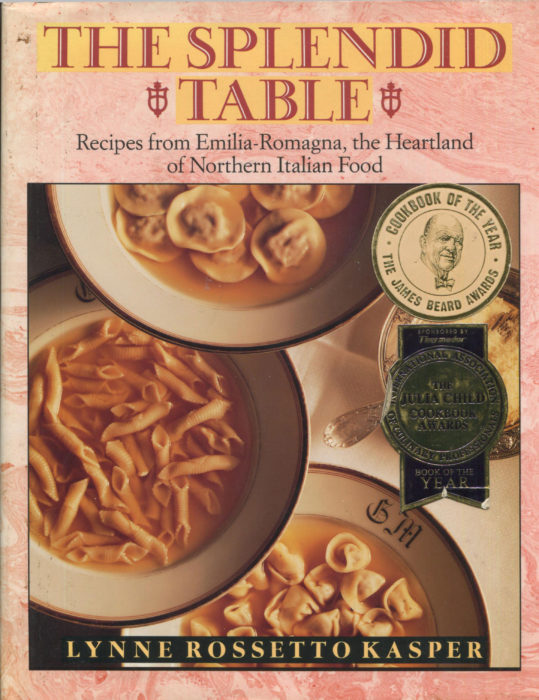
You may well know the name Lynne Rossetto Kasper. If you listen to NPR, her voice must surely have come through your speakers. Her radio program, The Splendid Table, was a weekend joy — the program continues but after 20 years as a gracious host, Lynne stepped aside just last year.
That phrase, The Splendid Table, is the title of her most famous cookbook. She has written over half a dozen cookbooks, but this one is the hallmark. A most substantial one. Written in 1992, the book is subtitled: Recipes from Emilia-Romagna, the Heartland of Northern Italian Food. That title, with its careful note that this is Northern Italy, is perfectly descriptive. Many of us consider the 500 pages here to be the Bible of Northern Italian cuisine.
Oh, dear, I may just have insulted several Italian authors. But, I’m going to make a little modification: this is the best book available in English for someone seeking the ultimate description of Northern Italian cuisine. I think we can all agree with that!
Lynne’s book begins with a most wise discussion that introduces Emilia-Romagna. Many people do not recognize that name. But say the words “Parmesan” or “Prosciutto” and you will nod with familiarity. Those are just two of the foods — technically Parmigiano-Reggiano and Prosciutto di Parma — that define Emilia-Romagna as that culinary heartland for all of Italy.
The combination of climate, terroir and the tides of history have made E-R just this central area where literally “everything came together.” The region is not homogeneous with great variety running west-to-east and even north-to-south. That variation began when Etruscans, Greeks, Romans, and Gauls all extended their influence for centuries at a time.
This portrait of E-R paints a picture of just the last 500 years of food, beginning with the Renaissance. [Imagine an attempt of the past 500 years of American cuisine!] The chapters reflect the very style of an Italian table:
- The Antipasto Course
- Ragus
- Essential Sauces and Stocks
- Pastas
- The Sweet Pastas of the Renaissance
- Risotto, Soup and Vegetable First Courses
- Second Courses [Seafood, Poultry, and Meats]
- Vegetable Side Dishes
- Breads
- Desserts
The book is a treasure chest and I’m happy to offer some of the nuggets from two interesting and special chapters: Ragus and The Sweet Pastas of the Renaissance
Lynne notes that while pasta reigns as queen, it is the ragus that are the king. Here are some key ragu ideas:
The Cardinal Ragu with skirt steak and cinnamon
Baroque Ragu with pancetta, sausage, chicken thighs, turkey giblets, and chuck beef,
Country Style Ragu with veal shoulder, pork loin, sausage, skirt steak and Prosciutto di Parma
Game Ragu with venison, hare, wild board, rabbit, or elk in any combination
Ah, Lynne does note at the start of the chapter that ragus here are meat-intense. I think these recipe ideas may have convinced you of that. More importantly, the next time you want a sauce for pappardelle, well, you just might want to turn to this exciting chapter.
Now, what is a “sweet pasta of the Renaissance?” The origins here are the spice trade that ended in Italy and the bounty of religious holidays where meals were to be meatless. Meatless but still interesting. So, the recipes here incorporate cinnamon, nutmeg, lots of pepper, rosewater, sugar, and lemon zest. These are pasta ideas that you probably won’t find at your corner American-Italian restaurant. Ideas like:
Tagliatelle with Caramelized Oranges and Almonds
Rosewater Maccheroni Romanesca
Sweet Vermicelli Pancake
These are lovely recipes, historically interesting, and offering you a flavor twist to savor.
Turn to any page in The Splendid Table and you’ll immediately understand why “splendid” applies. On any page. On every page.
The Splendid Table is now 36 years old. Middle age in full stride.
